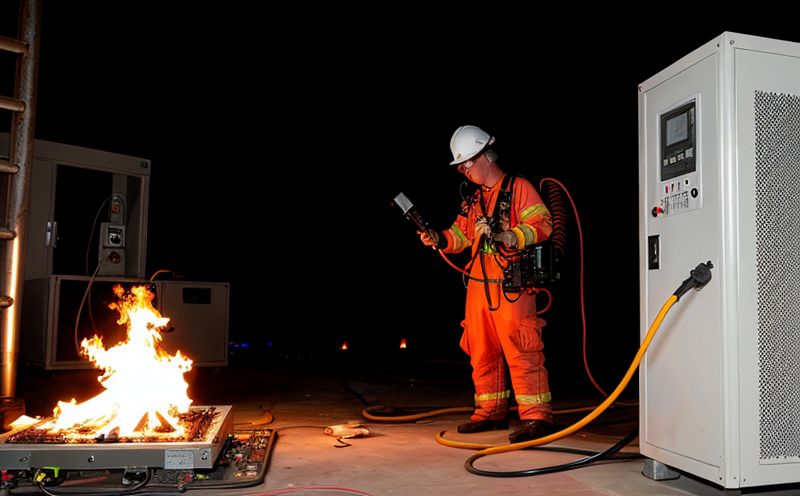Electrical & Electronic Equipment Fire Testing
The Electrical & Electronic Equipment (EEE) fire testing is a critical component of ensuring public safety and compliance with international standards. In this context, the focus is on identifying potential flammability hazards in electrical and electronic devices to prevent fires that could lead to accidents or property damage.
Testing these devices involves subjecting them to controlled environments designed to simulate real-world scenarios where they might encounter heat sources, mechanical abrasion, or other factors that could initiate a fire. The goal is to determine the ignition temperature and flame spread behavior of EEEs under various conditions.
The testing process typically begins with a detailed review of the design specifications and materials used in the construction of the device. This helps establish baseline parameters for the tests, ensuring accurate results that reflect real-world performance. Specimen preparation is crucial; it involves selecting representative samples from different parts of the product to ensure comprehensive coverage.
Once prepared, specimens undergo a series of standardized tests according to international standards such as IEC 60335-2-41 (Electrical apparatus for household and similar purposes - Part 2-41: Safety - Fire hazards) or UL 94 (Plastics Materials). These tests may include thermogravimetric analysis, calorimeters, oxygen index testing, and cone calorimeter tests.
The data collected during these tests provides insights into the thermal stability of materials used in EEEs. It also helps assess how quickly flames will spread across surfaces or components when exposed to ignition sources. Understanding this information is vital for manufacturers who want to improve product safety without compromising functionality.
Another important aspect of fire testing is understanding post-test analysis and reporting. After conducting tests, laboratories analyze the results meticulously using advanced software tools capable of interpreting complex data sets generated by various instruments. Reports typically include detailed descriptions of test procedures followed, observed phenomena during testing, calculated values like heat release rate (HRR), smoke production rate (SPR), and mass loss.
These reports serve multiple purposes: they inform manufacturers about necessary design modifications to enhance fire safety; guide regulatory bodies in setting appropriate limits for acceptable levels of flammability; and provide consumers with peace-of-mind knowledge regarding the products they purchase. By adhering strictly to these rigorous testing protocols, laboratories contribute significantly towards creating safer environments by minimizing risks associated with EEEs.
In conclusion, Electrical & Electronic Equipment fire testing plays an indispensable role in safeguarding lives and properties against potential hazards posed by poorly designed or manufactured electronic devices. Through meticulous examination of materials used in construction, rigorous application of internationally recognized standards, precise measurement techniques, and thorough interpretation of data collected during tests, laboratories ensure compliance with regulations while promoting innovation within the industry.
Industry Applications
The importance of Electrical & Electronic Equipment fire testing extends beyond mere compliance; it has wide-ranging applications across various sectors including consumer electronics, automotive manufacturing, aviation technology, and more. Consumer electronics manufacturers rely heavily on this service to ensure their products meet stringent safety requirements set forth by regulatory bodies worldwide.
In the automotive industry, EEEs are integral components of vehicles' electrical systems which control everything from lighting to braking mechanisms. Ensuring these devices do not ignite fires under normal operating conditions is paramount for maintaining vehicle integrity and passenger safety during accidents or malfunctions.
Aerospace companies also utilize Electrical & Electronic Equipment fire testing extensively due to the stringent safety standards required in this highly regulated sector. Aircraft components such as wiring harnesses, circuit boards, and other electronic assemblies must pass rigorous tests before being approved for use on commercial flights.
Customer Impact and Satisfaction
The impact of Electrical & Electronic Equipment fire testing reaches far beyond just the manufacturers involved; it directly influences customer satisfaction by enhancing overall product safety. When consumers buy products that have successfully passed rigorous fire tests, they can rest assured knowing these items are less likely to catch fire under adverse conditions.
Moreover, satisfied customers often translate into increased brand loyalty and repeat purchases, which benefits both the manufacturer and retailer alike. From a broader perspective, reducing incidents of fires caused by faulty electrical and electronic equipment contributes positively towards improving public health outcomes globally.
Laboratories that specialize in providing Electrical & Electronic Equipment fire testing services contribute significantly to achieving these positive impacts through their expertise and commitment to quality assurance practices. By adhering strictly to internationally recognized standards, laboratories ensure accurate and reliable test results that instill confidence among all stakeholders involved.
Use Cases and Application Examples
| Use Case/Application Example | Description |
|---|---|
| Consumer Electronics | Testing of smartphones, tablets, and laptops to ensure they meet safety standards related to flammability. |
| Automotive Industry | Evaluation of wiring harnesses and other electronic components within cars to prevent potential fire risks during accidents or malfunctions. |
| Aerospace Technology | Inspection of avionics systems, including circuit boards and displays, before their integration into aircrafts for flight safety purposes. |
| Medical Devices | Evaluation of life support devices like ventilators to ensure they remain safe even if exposed to extreme temperatures or sparks. |
| Home Appliances | Testing of refrigerators, washing machines, and other household appliances for their resistance against spontaneous combustion due to overheating issues. |
| Railway Systems | Evaluation of signaling equipment used in train operations to guarantee reliable performance under all weather conditions without causing any ignition sources. |
| Industrial Machinery | Assessment of motors, controllers, and other components within industrial machinery to ensure they do not pose fire hazards during operation or maintenance activities. |
| Data Centers | Evaluation of server racks and cooling systems in data centers to prevent overheating incidents that could lead to catastrophic failures. |





